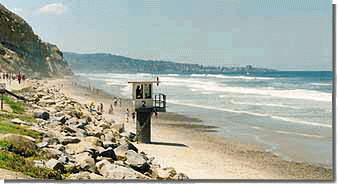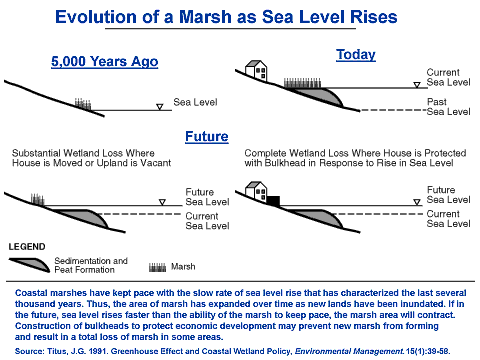

Coastal Impacts
Sea level is rising slowly worldwide. Studies have estimated that along the Gulf and Atlantic coasts, a one foot (30 cm) rise in sea level is likely by 2050 and could occur as soon as 2025. In the next century, a two foot rise is most likely, but a four foot rise is possible; and sea level will probably continue to rise for several centuries, even if global temperatures were to stop rising a few decades hence.
Rising sea level inundates wetlands and other low-lying lands, erodes beaches, intensifies flooding, and increases the salinity of rivers, bays, and groundwater tables. Some of these effects may be further compounded by other effects of changing climate. Measures that people take to protect private property from rising sea level may have adverse effects on the environment and on public uses of beaches and waterways. Federal, state, and local governments are already starting to take measures to prepare for the consequences of rising sea level.
Coastal marshes and swamps are particularly vulnerable to rising sea level because they are mostly within a few feet of sea level. As the sea rises, the outer boundary of these wetlands will erode, and new wetlands will form inland as previously dry areas are flooded by the higher water levels. The amount of newly created wetlands, however, will be much smaller than the area of wetlands that are lost. The amount of dryland within a few feet above the wetlands is much less than the area of wetlands that would be lost if sea level rises a few feet. Moreover, developed areas will often be protected with bulkheads, dikes, and other structures that keep new wetlands from forming inland.
Along sandy beaches, like wetland shores, one of the ways to halt erosion is to erect structures. Although these sea walls protect property, they can eliminate beaches, particularly bay beaches, which are usually less than 10 feet wide. Beaches are used for fishing, recreation, transportation, and landing small crafts, in addition to their environmental importance. Changing climate also increases the vulnerability of coastal areas to flooding. A higher sea level raises the flood level from a storm of a given severity. A 3-foot rise in sea level (for example) would enable a 15-year storm to flood many areas that today are only flooded by a 100-year storm. Coastal flooding is also exacerbated by increasing rainfall intensity. Along tidal rivers and in extremely flat areas, floods can be caused by storm surges from the sea or by river surges.
Finally, rising sea level tends to increase the salinity of both surface water and ground water.
